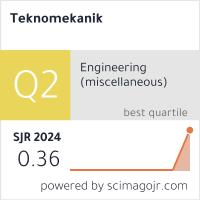Characteristics of Calorific Value of Briquettes Made From Cymbopogon Citratus Waste As an Alternative Fuel
DOI:
https://doi.org/10.24036/teknomekanik.v5i1.12572Keywords:
Briquett, Cymbopogon citratus, Waste, Calorific Value, Alternative fuelAbstract
Product diversification through Cymbopogon citratus briquettes as an alternative fuel for the development of renewable energy. The waste from the Cymbopogon citratus production process is a potential source of renewable energy that can be used as briquettes. This is an alternative to reduce dependence on fuel oil energy which is the main need for ordinary people. The purpose of developing Cymbopogon citratus waste briquettes with various variances and the use of tapioca adhesive, in obtaining the characteristics of the calorific value of briquettes. The method of making briquettes by using a press and optimizing the composition of the appropriate mixture as an effort to get the calorific value. From this research, the calorific value of Cymbopogon citratus briquettes is 8230.65 kJ/kg at a percentage mixture of 90 : 10 and its density is 394.90 kg/m3. From the acquisition of these characteristic values, it can be recommended as an alternative fuel in an effort to develop renewable energy in the utilization of lemongrass waste.
Downloads
References
Y. Kurniawan and H. Santoso, “Listrik sebagai ko-produk potensial pabrik gula,” Jurnal Litbang Pertanian, vol. 28, no. 1, p. 23, 2009.
Pri Agung Rakhmanto, “Ketahanan Energi Indonesia Rapuh,” kompas.com, Nopembert 2013. [Online]. Available: https://money.kompas.com/read/2013/05/30/07482479
P. R. Indonesia, “Peraturan Presiden Republik Indonesia Nomor 5 Tahun 2006 Tentang Kebijakan Energi Nasional,” Jakarta: Batan Pertahanan Nasional, 2006.
D. Energi and S. D. Mineral, “Statistik Energi Indonesia.” On-line). www. isjd. pdii. lipi. go. id. Diakses, 2004.
V. K. Tyagi and S.-L. Lo, “Sludge: a waste or renewable source for energy and resources recovery?,” Renewable and Sustainable Energy Reviews, vol. 25, pp. 708–728, 2013.
H. Nurdin, H. Hasanuddin, and D. Darmawi, “Karakteristik Nilai Kalor Briket Tebu Tibarau Sebagai Bahan Bakar Alternatif,” INVOTEK: Jurnal Inovasi Vokasional dan Teknologi, vol. 18, no. 1, pp. 19–24, 2018.
H. Nurdin, H. Hasanuddin, D. Darmawi, and F. Prasetya, “Analysis of calorific value of Tibarau cane briquette,” in IOP Conference Series: Materials Science and Engineering, 2018, vol. 335, no. 1, p. 012058.
H. Nurdin and D. Y. Sari, “Characteristic of Areca Fiber Briquettes as Alternative Energy,” in Journal of Physics: Conference Series, 2020, vol. 1594, no. 1, p. 012049.
American Society for Testing and Materials (ASTM) D5865, 2004. Standard test method for gross calorific value of coal and coke. In: 2004 Annual Book of ASTM Standards, Gaseous Fuels; Coal and Coke, vol. Vol. 05.06. ASTM, Philadelphia, PA, pp 519-529.
C.-T. Tan, “Beverage emulsions.,” Beverage emulsions., no. Ed. 2, pp. 445–478, 1990.
G. A. van der Doelen, K. J. van den Berg, and J. J. Boon, “Comparative chromatographic and mass-spectrometric studies of triterpenoid varnishes: fresh material and aged samples from paintings,” Studies in Conservation, vol. 43, no. 4, pp. 249–264, 1998.
N. Mulyono and A. Apriantono, “Sifat fisik, kimia dan fungsional damar,” 2004.

Downloads
Published
Issue
Section
License
Copyright (c) 2022 Hendri - Nurdin, Wagino Wagino, Batu Mahadi Siregar (Author)

This work is licensed under a Creative Commons Attribution 4.0 International License.




